Plants of the mixed-grass prairies
A selection of the beautiful and fascinating plants of Canada’s most widespread type of grasslands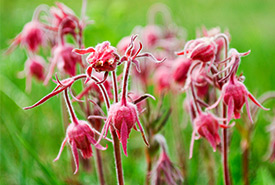
Three-flowered avens (Photo by Sean Feagan / NCC Staff)
From afar, the mixed-grass prairies might look like a uniform sea of grass. But walk through one of these grasslands, and you will encounter a variety of interesting plants.
Mixed-grass prairie is the most widespread type of grassland in Alberta and there are both the mixed-grass and dry mixed-grass subregions, which together comprise about 10 per cent of the area of the province.
These prairie ecosystems are named after the mixture of mid-height and short grasses that make up their habitat. Grasses are not the only plants found there, however, as these regions also support a diversity of forbs (herbaceous plants), as well as several important shrub (woody) species.
Keep reading to learn about some of the interesting plants found in the incredible grasslands of Alberta and Saskatchewan!
Lichens & mosses
While visiting mixed-grass prairie, if you kneel and look closely to the ground, you will see a complex and colourful community of lichens and mosses growing low on the ground surface between the grasses.
These lifeforms might be easy to overlook, but they help cover and protect the sensitive prairie soils. This is one of the most fragile parts of the prairie ecosystem; if disturbed it can take decades to recover, if at all.
Prairie spikemoss
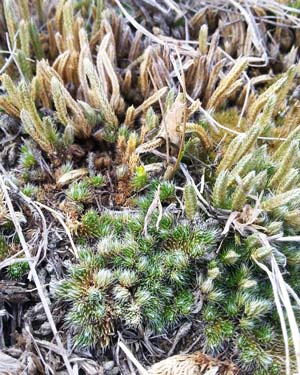
Prairie spikemoss (Photo by Lee Moltzahn / NCC Staff)
One of the most interesting plants found is known as the prairie or lesser spikemoss. These creeping plants are members of the clubmoss family, and are not closely related to true mosses. They have a simple vascular system and scale-like leaves and form dense mats. Unlike the other plants mentioned below, prairie spikemoss produces spores rather than seeds.
Thread-leaved sedge
Sedges in the genus Carex are one of the most diverse groups of flowering plants. Many species grow in wet areas, but some have adapted to life in the dry and sunny mixed-grass prairie. One of the most common of these is thread-leaved sedge, which as its name implies, has thin, wispy leaves.
These grass-like plants are diminutive, and their identification can be challenging — so get those hand lenses ready! Having a close look at this plant can help one see its distinctive red-brown leaf sheaths.
Thread-leaved sedges are resistant to grazing and are one of the first plants to colonize an area after disturbance.
Enjoying this story? Sign up for our newsletter!
Blue grama grass
Dwarfing over the small sedges and clubmosses, this short grass grows in tufts of curly leaves and forms dense mats.
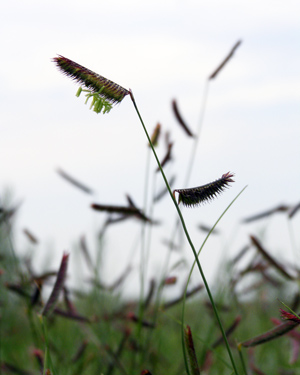
Blue gramma grass (Photo by Lee Moltzahn / NCC Staff)
This adaptable species can grow in some of the driest conditions across the prairie grasslands. Blue grama is highly nutritional for cattle, particularly during fall and winter.
Blue grama grass has perhaps one of the most endearing flower heads of any grass: it is shaped like an eyebrow!
Needle and thread grass
Anyone who has walked through needle and thread grass might remember a sharp pain after its point-tipped seeds moved through their socks and pierced their skin.
Although sometimes painful, the seeds of this medium-height grass are fascinating. Each seed is attached to a long projection known as an awn, which is twisted like a screw. After seeds are released and humidity increases, the awns untwist, causing the seed to be drilled into the ground!
The provincial grass of Saskatchewan, needle and thread is considered one of the most important grasses of the mixed-grass prairies and is one of the dominant climax species (a plant characteristic of an undisturbed, mature ecosystem) there. It is a favourite food of wildlife, especially early in the spring. Its shoots are eaten by black-tailed prairie dogs, northern pocket gophers and white-tailed jackrabbits.
Want to help save mixedgrass prairies? Learn more about the Prairie Grasslands Action Plan!
Western wheatgrass
There are several species of native wheatgrass that can be found in mixed-grass prairie, with northern and western wheatgrass being the most common species. The seeds of these grasses grow in a vertical spike, and they also spread through underground stems known as rhizomes.
Western wheatgrass does well in wet conditions and is tolerant of alkaline or saline areas, often growing into dense matts. Because of this, it is often used for erosion control or to stabilize restoration sites.
Three-flowered avens
Three-flowered avens among the most common broadleaf flowering plants seen on the mixed-grass prairies, although they are found in parkland and foothill areas as well. An early bloomer, this plant produces reddish-purple nodding flowers, which, as their name implies, grow in groups of three. These flowers are an important spring food source for pollinators.
This member of the rose family is also known as prairie smoke. Its seed heads feature feathery projections that, when lit up at dawn or sunset, resemble smoke hanging low over the ground.
Purple prairie clover
Despite its name, purple prairie clover is not a true clover. However, like true clovers, this plant is a member of the pea family and can fix nitrogen, which helps fertilize the soil. This perennial plant has a high protein content, meaning it is valuable forage for many grazers, including pronghorn.
Purple prairie clover produces beautiful flowers, which are actually groups of hundreds of tiny individual flowers growing together on a cone-like flower spike. Its blooms are loved by pollinators, including several members of the plasterer bees specialized to this plant.
Seeds of purple prairie clover are often available commercially, so it is a great choice if you would like a piece of the prairie in your own backyard.
Dotted blazing star
This perennial wildflower is named after the spots visible on its narrow, grass-like leaves.
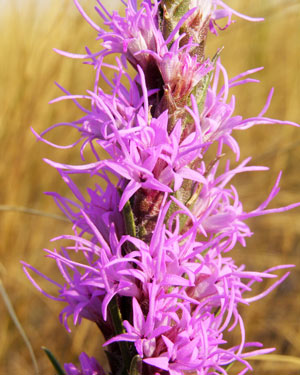
Dotted blazingstar in bloom (Photo by Lee Moltzahn / NCC Staff)
Dotted blazing star produces stunning pink to purple flowers, growing on a large spike measuring up to 25 centimetres tall. It is a late blooming species, with flowers seen as late as September.
Dotted blazing star seeds are covered with a tuft of hair to help disperse them in the wind. This is an important plant for wildlife, as its flowers provide nectar for pollinators, while birds enjoy its seeds.
The fantastic blooms of dotted blazing star did not go unnoticed by horticulturalists, and now many cultivars are commonly planted in gardens. But if you decide to plant one in your yard, consider finding a native variety.
Plains prickly pear
Those exploring the prairie need to watch where they step or sit for a rest — otherwise they might get poked by the large spines of this cactus. This plant is common in badlands environments but can also be found growing in open grasslands.
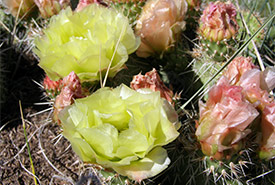
Prickly pear cactus in bloom (Photo by Lee Moltzahn / NCC Staff)
Segments of this cactus are flattened and can grow up to 12 centimetres long. These cacti produce up to a dozen large, vibrant yellow flowers on each plant. These flowers are coveted by a range of pollinators but are particularly loved by bees. Prickly pears are named after their fruit, which is often compared to pineapple in taste.
Perfectly adapted to dry environments, plains prickly pear has shallow roots that help draw in moisture, and a thick cuticle that helps prevent water loss. The spines are modified leaves that act to keep hungry and thirsty herbivores at bay. This cactus also has smaller spines that help to reflect the sun.
Prairie rose
Another dry-tolerant prickly plant is the prairie rose. Unlike the typical garden rose, this rose species grows very low to the ground. But like garden roses, prairie roses produce beautiful and fragrant white to pink flowers.
Prairie roses spread from underground stems and form dense colonies. It is smaller than other native rose species and grows up to a dozen leaflets.
Prairie rose fruits, known as hips, turn bright red in the fall. They are an important food source for wildlife, including many birds and even coyotes. Despite its small thorns, its leaves are browsed by wildlife, such as mule deer and pronghorn.
Sagebrush
Sagebrush typically grows to about waist height and features gnarled trunks that often twist into peculiar shapes. When crushed, its grey leaves produce a spicy, bitter smell. A member of the aster family, its pale-yellow flowers bloom in late summer and are pollinated by the wind.
Sagebrush is found in dry environments, including badlands and dry grasslands. In some areas, it will form dense stands. When attacked by insect predators, sagebrush can release special chemicals that signal to other plants to ramp up their defenses.
Many wildlife rely on sagebrush for food and cover. Its leaves contain high amounts of proteins, fats and carbohydrates, making it a favorite food of deer, moose, elk, pronghorn and bighorn sheep. Sage grouse, as their name implies, are dependent on this plant for food, cover and nest sites.





